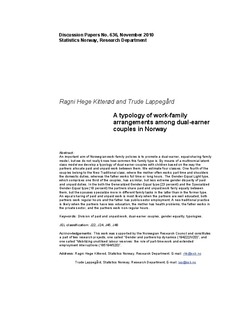| dc.contributor.author | Kitterød, Ragni Hege | |
| dc.contributor.author | Lappegård, Trude | |
| dc.date.accessioned | 2010-11-30T09:34:37Z | |
| dc.date.available | 2010-11-30T09:34:37Z | |
| dc.date.issued | 2010 | |
| dc.identifier.issn | 0809-733X | |
| dc.identifier.uri | http://hdl.handle.net/11250/180377 | |
| dc.description.abstract | An important aim of Norwegian work-family policies is to promote a dual-earner, equal-sharing family model, but we do not really know how common this family type is. By means of a multinomial latent-class model we develop a typology of dual-earner couples with children based on the way the partners allocate paid and unpaid work between them. We estimate four classes. One fourth of the couples belong to the Neo-Traditional class, where the mother often works part time and shoulders the domestic duties, whereas the father works full time or long hours. The Gender-Equal Light type, which comprises one third of the couples, has a similar, but less extreme gender disparity of paid and unpaid duties. In the both the Generalized Gender-Equal type (23 percent) and the Specialized Gender-Equal type (18 percent) the partners share paid and unpaid work fairly equally between them, but the spouses specialize more in different family tasks in the latter than in the former type. An equal sharing of paid and unpaid work is most likely when the partners are well educated, both partners work regular hours and the father has public-sector employment. A neo-traditional practice is likely when the partners have less education, the mother has health problems, the father works in the private sector, and the partners work non-regular hours. | en_US |
| dc.description.sponsorship | This work was supported by the Norwegian Research Council. | en_US |
| dc.language.iso | eng | en_US |
| dc.publisher | Statistics Norway, Research Department | en_US |
| dc.relation.ispartofseries | Discussion Papers;636 | |
| dc.subject | Unpaid work | en_US |
| dc.subject | Dual-earner couples | en_US |
| dc.subject | Gender equality | en_US |
| dc.subject | Labor market | en_US |
| dc.subject | Labor productivity | en_US |
| dc.subject | Labor supply | en_US |
| dc.subject | Arbeidsmarked | en_US |
| dc.subject | Sysselsetting | en_US |
| dc.subject | Lønninger | en_US |
| dc.subject | Arbeid | en_US |
| dc.subject | Likestilling | en_US |
| dc.subject | Menn | en_US |
| dc.subject | Kvinner | en_US |
| dc.subject | Ulønnet arbeid | en_US |
| dc.subject | Husholdninger | en_US |
| dc.subject | JEL classification: J22 | en_US |
| dc.subject | JEL classification: J24 | en_US |
| dc.subject | JEL classification: J45 | en_US |
| dc.subject | JEL classification: J48 | en_US |
| dc.title | A typology of work-family arrangements among dual-earner couples in Norway | en_US |
| dc.type | Working paper | en_US |
| dc.subject.nsi | VDP::Social science: 200::Economics: 210 | en_US |
| dc.subject.nsi | VDP::Social science: 200::Women's and gender studies: 370 | en_US |
| dc.source.pagenumber | 32 | en_US |
